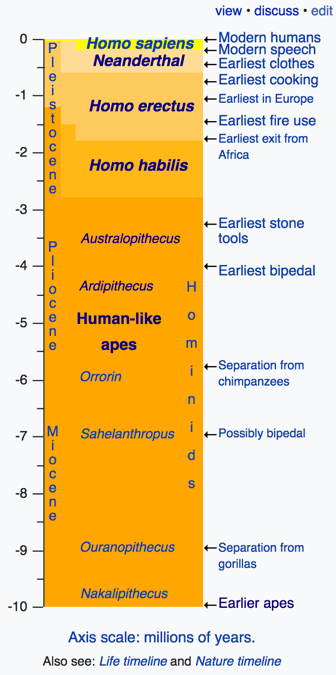I recently finished reading Sapiens: A Brief History of Humankind by Yuval Noah Hurari and it has safely earned a spot on the list of my favorite books.
The story follows a rough historical timeline starting millions of years ago with the evolution of homo sapiens and ending with Ray Kurzweil-esq predictions for the future of human technology. I enjoyed the whole text, but the best part by far was the first 100 pages where Hurari addresses a question that I’ve never even thought to ask before:
Why are sapiens the only humans?
After all – there are many species of cats (the genus “Felis”), from house cats (felis catus) to jungle cats, (felis chaus) and there are many species of dogs (genus “canus”), from common domesticated dogs (cannis lupus familiaris) to coyotes (canis latrans), why aren’t there many species of humans (genus “homo”)?
The answer is: there were. Once upon a time there were multiple species of humans.
This helpful timeline from Wikipedia shows most of the (known) species of humans:
However, whereas this diagram largely presents human species in a sequential manor – where each species of humans gave way to the next newer version, according to Hurari, it’s more likely that these human species cohabitated the earth for a period of time.
Like a true story teller, Hurari paints a vivid picture of what the world might have looked like when different kinds of humans roamed the earth. However, that story quickly turns into a murder mystery as – today – all of the non-sapiens humans are gone.
There are two prominent theories for why, today, sapiens are the only humans:
- Different human species peacefully integrated and co-bred their differences away leaving only one combined/inter-mingled human species
- Sapiens killed all of the other humans in a mass genocide
Pausing for a minute… based on everything you know about sapiens, which one do you think it was?
After much discourse, Hurari concludes that it was probably a mix of the two, where there was a small amount of co-breeding and a lot of genocide.
Back to the central question: why are sapiens the only humans? What about Sapiens allowed them to triumph over (and perhaps kill) all other human species?
The topic of communication is addressed briefly – as humans are somewhat unique in their usage of language. However, as Hurari explains, communication is something that many animals can do. Monkeys have different tones or calls to indicate different types of danger (e.g one call to indicate “look out for that bird” and one call to indicate “look out for that lion”) and some breeds of parrots can say any word a human can say.
However, as Hurari puts it: only sapiens can say “the lion is the guardian spirit of our tribe”.
Believing things that have no physical evidence – and through that belief cooperating on a scale that transcends the limits of personal relationships: that’s what makes sapiens unique.
If you think about it – today, we believe in all sorts of constructs that have no presence in the physical world from religion, to government, to laws, to limited liability corporations. All of these things allow us to work and cooperate with a large number of people who we don’t know personally.
The downside of this unique gift is that it also makes sapiens uniquely capable of the sort of large scale cooperation necessary to commit genocide. If you believe Harari, this was perhaps the original sin that allows modern sapiens to dominate the world.
So – why are there Neo-Nazi’s and KKK members marching in the streets in Charlottesville? Well, they believe something that defies physical evidence and allows them to cooperate in a way that (as we saw in WWII) could lead them to commit genocide.
In software terms, it’s not a bug, it’s a feature. In some ways that’s what makes humans unique.
In my mind, that’s why these past few weeks have been so scary and why we need to treat the resurgence of racism and anti-Semitism very very seriously.
